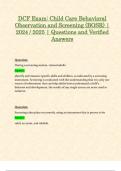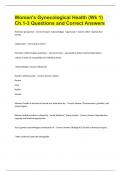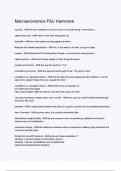USMLE Step 1 Behavioral Science /237
Questions And Answers 100% Score!!!
Quiz :Rate formula & key points - √Answer :Actual cases/Potential cases = RATE
Denominator is key*
(Who is at risk?)
RATE is normally = per 100,000 cases (cases of people at risk; denominator)
*Important point*: Most (95%) cases in the US for diseases are under
50/100,000, at most 100/100,000
Quiz :Incidence vs Prevalence differentiation - √Answer :Incidence (acute
conditions): NEW cases/population at risk (people who never got the disease,
etc.)
Prevalence (chronic conditions): ALL cases/population at risk
Differentiation:
- If individual already has the disease, he cannot be at risk for incidence; he is
already 'sick'; incidence only applies to NEW cases
- Prevalence applies to ALL cases, people who had the infection, people who
had the infection and healed, people who just got the infection in a period of
time; chronicity
Quiz :Attack rate - √Answer :Incidence
type of incidence rate in which the denominator is further reduced for some
known exposure
100 people goes to a italian restaurant
50 people ordered pasta
20 people of the 50 who ordered pasta got sick
general incidence rate = 20/100
specific incidence rate with attack rate involved = 20/50
,Exposures with the highest attack rate ratio will most likely be the source of
cause
Quiz :Relationship formula: prevalence and incidence - √Answer :Prevalence =
Incidence x Duration
P=IxD
Quiz :Morbidity rate - √Answer :rate of disease in population at risk; refers to
both incident and prevalent cases
Quiz :Mortality rate - √Answer :rate of death in a population at risk refers to
incident cases only
mortality refers to the 'NEWLY' dead, due to cause of the onset of a NEW
infection
Quiz :Prevalence Pot - √Answer :Reservoir = population at risk
As the population at risk develops onset of disease, it is categorized as
incidence rate
Over time, the accumulation of incidence rate disease becomes the prevalence
cases of chronicity
Prevalence cases either recovers or dies (mortality; incidence)
Quiz :Incidence vs. Prevalence situations: - √Answer :
Quiz :Incidence vs. Prevalence situations: 2nd portion - √Answer :
Quiz :AIDS cases graph readings: incidence rate + prevalence rate + point
prevalence - √Answer :1990~1991 Incidence rate + Prevalence rate
I = 4/6
(onset = 3, 4, 6, 9; at risk= 3, 4, 6, 8, 9, 10)
P = 7/9
(all cases within 1990~1991 = 1, 3, 4, 5, 6, 7, 9; at risk group = only person NOT
at risk is 2 due to death before period of inspection)
,Point prevalence rate of 1/1/1991
PP = 4/6
(all cases on 1/1/1991 = 3, 4, 7, 9; at risk is anyone that did NOT die before
1/1/1991 = 3, 4, 7, 8, 9, 10)
Quiz :Crude rate = ? - √Answer :for the whole population
almost never use this; due to almost impossible comparison of 2 population
with equal points
Quiz :Specific rate = ? - √Answer :for the sub-group of the population
gender-specific
age-specific
nationality-specific
Quiz :Adjusted rate/Standardized rate = ? - √Answer :getting clean comparison
to adjust 2 groups of different demographics/race/gender/age etc. to the same
level for a better comparison
Men vs. woman in MI
- better as age-adjusted data
White vs. Blacks in stomach cancer
- better as age-adjusted data
Quiz :How to interpret date: Physicians are more likely to commit suicide in the
U.S. - √Answer :First reaction: stress, access to pharmaceuticals, long working
hrs.....WRONG
First correct reaction is to see the type of data it is
It is known study people of higher SES is more likely to commit suicide vs.
people of lower SES
Doctors are known to be more commonly in the higher SES group
, By collected a SES-group-adjusted data, by finding doctors of low SES to
compare on common ground with low SES population;
if the suicide rate is identical then the initial data only suggests what the
previous research already discovered: it was simply a SES issue
Quiz :Crude mortality rate - √Answer :Death/Population
Quiz :Cause-specific mortality rate - √Answer :Death by specific
cause/population
Quiz :Case-fatality rate - √Answer :death from cause/population with the cause
Quiz :Proportionate mortality rate - √Answer :death from cause/all death
Quiz :Screening test: Sensitivity vs. Specificity - √Answer :SPIN & SNOUT
(being "in" means being healthy; "out" as in taken out, diseased)
Sensitivity: "all we care about is disease" aka the PRESENT column; identifying
the cases of truly diseased efficacy amongst the diseased
- True positives + False negatives = all the people with the disease
- formula: TP/(TP+FN)
Specificity: "the non-disease" aka the ABSENT and the HEALTHY; identifying
truly healthy individuals amongst the healthy
- True negatives + false positives = all the healthy people
- formula: TN/(TN+FP)
if 20 people are gathered, 10 have AIDS, 10 are healthy, a new screening test
developed wants to know its sensitivity and specificity, results are shown
- positives = 15 (9 are true, 6 are false)
- negatives = 5 (3 are true, 2 are false)
Sensitivity (diseased) = 9/(9+2) = ~81%
Specificity (healthy) = 5/(5+6) = ~45%
Positive predictive value = 9/(9+6) = 60%
Negative predictive value = 3/(3+2) = 60%






